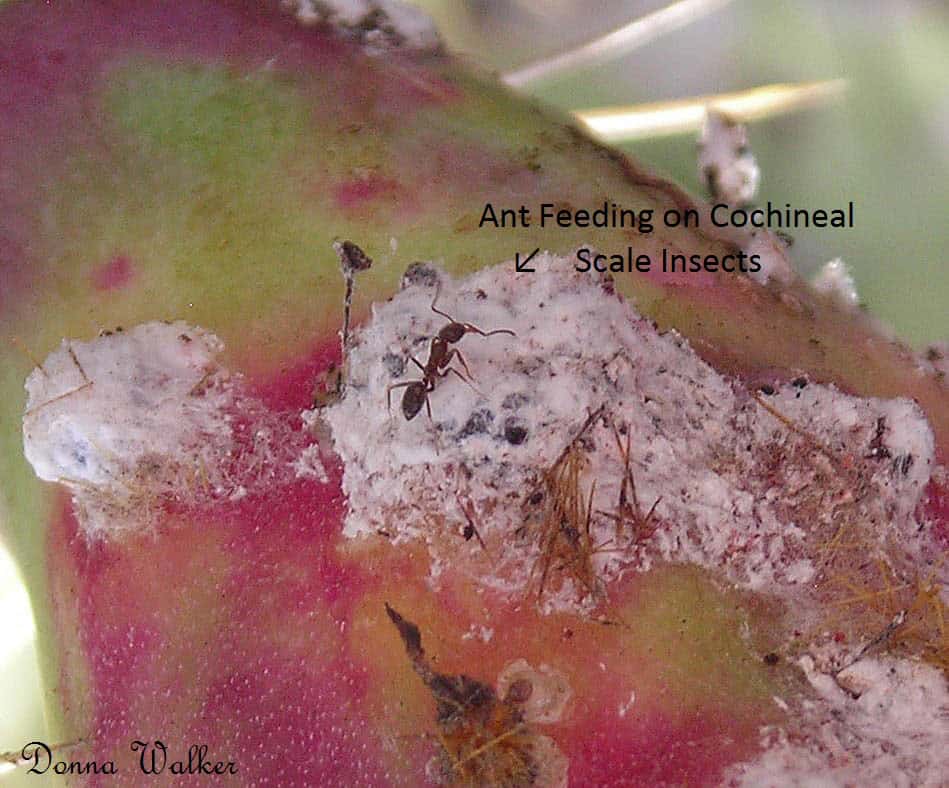Bugs in Your Food – On Purpose!
(Note: some of the photos are graphic in their content regarding bugs)
Do you eat yogurt with strawberries? How about pink grapefruit juice, or red velvet cake? Most likely you are consuming bugs……a particular scale insect to be exact. It´s called “cochineal,” harvested in South America and Mexico from the prickly pear cactus.

Now your food manufactures don´t come right out and say that cochineal bugs are used as an ingredient for adding red and purple coloring…..instead, they give it names like “Carmine, Crimson Lake, Natural Red 4, C.I. 75470 or E120.” Using bugs for food coloring doesn´t just stop at yogurts and juices from the supermarket; a famous coffee chain, you know the one, has recently changed their “natural coloring” in their strawberry smoothies.

Evidently, the company received a lot of flak from vegan and vegetarian communities for serving bugs in their drinks. If you are eating or drinking something red, you might be eating ground up insects under the guise of “natural coloring! Check out the ingredients on your next strawberry or berry yogurt.

Beneath the beautiful flowers of the prickly pear cactus, grows what appears to be, a white mold; underneath is where the cochineal scale insect lives. When crushed, female cochineal insects make a deep crimson red used as “natural coloring” in both food and cosmetics, especially red lipstick.

Under the white mold-like substance on the cactus are cochineal insects.
Video by N.C. Museum of Natural Sciences of Cochineal Used as Food Coloring
Coloring with Cochineal – A little History

Cochineal scale insects are native to South America and Mexico, however, they can be found on prickly pear cacti right here in southern California. In the 1600 and 1700´s, cochineal insects were harvested from the cactus to create an intense red dye for wool and cotton. The process required extensive labor to gather the insects but became a lucrative commodity for both Mexico and Spain. Cochineal became an important export during colonial times and until the invention of artificial (chemical) dyes.

Cochineal insects produce what is called “Carminic” acid to protect themselves from predators. Dye and paint is made from this acid by extracting it from the female beetles´ body and eggs. Michelangelo and other early artists used Carmine in their paintings to create deep crimsons, oranges, and others shades of red.

Today, the art of gathering cochineal and making red dye is practiced as a tradition and a hobby, rather than for big textile industries. However, cochineal dye has re-entered the market as a “natural” colorant because many synthetic commercial red dyes have been found to be carcinogenic. But, it has also been discovered that in rare cases, Carmine induces an anaphylactic shock. Because of this possibility, using the cochineal insect for food coloring has become a controversial topic, causing some food manufacturers to look for other alternatives in red coloring.

Many food manufacturers have switched to chemical dyes such as Red 40, also called: Allura Red AC, Food Red 17, C.I. 16035, FD&C Red 40, and E129) which is mostly petroleum. This chemical red coloring is also in candy. The question is…. Does one go “natural” and purchase products with bug dye or are chemicals preferred as in the petroleum Red 40? Or, maybe one should just avoid red foods completely……. personally, I don´t mind a few bugs, even though I am a Pescetarian…… the bugs add more protein to my diet.


Article by Donna Walker
NOTE: The purpose of this article on “Bugs in Your Food” isn´t to upset or “gross” people out, it is to educate and encourage individuals to conduct research and to question just exactly what the meaning of the names are on our food labels …… and what´s really behind words like “natural” inside the ingredients. The more consumers begin to question the ingredients in their food; manufacturers will search out and study alternative methods that are healthier for us all. The good news is, according to National Geographic and the American Chemical Society, red dye is being developed from purple sweet potatoes to replace artificial coloring and cochineal bugs as a truly “natural” food coloring.
References
North Carolina Museum of Natural Sciences, “A Moment of Science: Cochineal Bugs.” 2011. YouTube.
Fiegl, A. (2013, September 19). “Scientist Make Red food Dye from Potatoes, Not Bugs.” National Geographic. Retrieved from https://news.nationalgeographic.com/
Wikipedia – Cochineal


